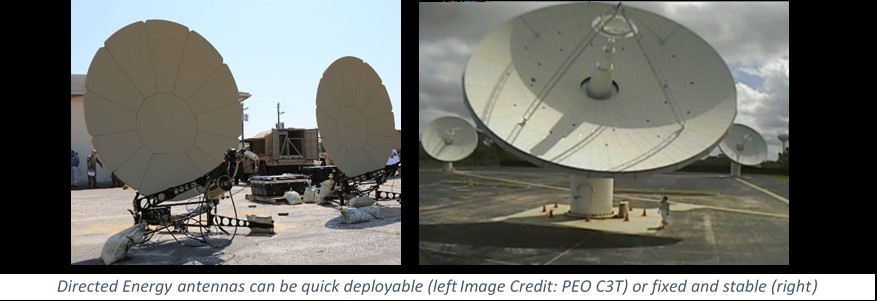Directed Energy
Precision, high power RF energy for cyber effects and more…
Directed energy (DE) has a wide range of uses from DE weapons to the transfer of RF power to hard-to-reach locations. Widely-spaced large antennas can be arrayed to transmit significant energy to a target.
DESCRIPTION
An array of large ground reflectors can be very powerful. A single antenna has power amplifier limitations but an array of antennas can be coherently combined indefinitely to send high-power RF energy to targets of interest. High power amplifiers (e.g. Klystrons or traveling wave tubes) can be used at each antenna and when arrayed together, the EIRP increases as the number of antennas squared (N2 effect). Combining 10 antennas provides 100 times the radiated power.
Even the large NASA Deep Space antennas are limited by the amount of power they can produce individually. As their power amplifiers get stronger, voltage arcs in the waveguides become imminent. Our arraying technology spreads the power among the antennas and recombines it at the target. Besides power considerations, single antennas are limited in surface area, thus sensitivity. However, there is no theoretical limit to the number of antennas that can be transmit arrayed, thus increasing the surface area so an array can always outperform a single antenna.
We demonstrated that we could accurately and robustly array large ground reflectors in 2010. Our coherent transmission from widely-spaced large ground reflectors is reliable and precise. Other approaches rely on periodic recalibration as part of their design. They risk being out-of-sync when they are needed the most. This is because the drift is unknown and only estimated between their recalibration events. By design, our technology doesn’t ever need re-calibration. It continuously and autonomously self-calibrates without looking away. Because it doesn’t rely on external calibration objects like satellites, balloons or towers, it is always ready, 24/7, for vital missions.
A benefit of RF versus laser directed energy is that RF energy at lower frequencies isn’t affected as much by atmospheric turbulence which absorbs and diffuses light energy. This makes it a better choice over laser for some applications. For instance, instead of damaging missiles with light energy, RF energy can be used to disable them. Similarly, for unfriendly communication networks.
INNOVATIONS
- Concentrated RF power on a target from an array of widely-spaced transmit arrayed antennas
- The system is instantly coherent upon power-up
- Unknown phase variation continually, autonomously corrected
- Can be a large fixed stable installation or quick deployable array
- Large, fixed stable antennas run open-loop; no feedback needed
- Quick deployable antennas can use passive uncooperative reflections from the target for feedback
EXAMPLE

For Directed Energy (DE) missions, RF energy is concentrated on an object using quick deployable or fixed, stable antenna arrays.
A powerful, fixed, stable array of large ground reflectors with high powered Klystron amplifiers can be weaponized to mitigate cyber security threats.
In another application, pointing a group of quick deployable antennas towards a surveillance drone in order to power its onboard equipment, sustain flight, or charge its battery is feasible. Additionally, the technology can also be used to get power to hard-to-reach locations. For instance, energy is collected at an object (e.g. a drone) and re-transmitted to an object of interest.
For tactical EW missions, cyber effects can be delivered over-the-horizon via radio signals using an array of antennas. The signal can be bounced off an air or space object to a location of interest on the ground. This has the potential to protect assets, since they don’t need to be deployed into threat areas.
BENEFITS
- The wide diameter of the antenna array provides precision targeting
- Supports many mission applications; many use cases
- Provides the ability to disable sensitive electronics for Electronic Warfare (EW) missions
- Can potentially be used to power batteries at a distance
- Applicable to small man-portable and large reflector antenna arrays
- Transmit arrays provide up to 6dB EIRP increase each time the number of elements is doubled; 4 antennas provides 12dB increase; 8 provides 18dB increase
- 10 arrayed transmit antennas provides 100 times the radiated power over a single antenna
- Ten 1.2 m quick deployable antennas have an EIRP of a 12m dish
- Seven 4.5m truck mounted antennas at 10GHz with 10kW Klystrons can produce ~6kW of power to a 1 m2 target at 2500’
- Twenty 12m antennas at 10 GHz with 10kW Klystrons can produce 4W/m2of power at a LEO satellite
- The inherent redundancy of the array makes it tolerant to individual element failures or routine maintenance
- Arrays are flexible and expandable
